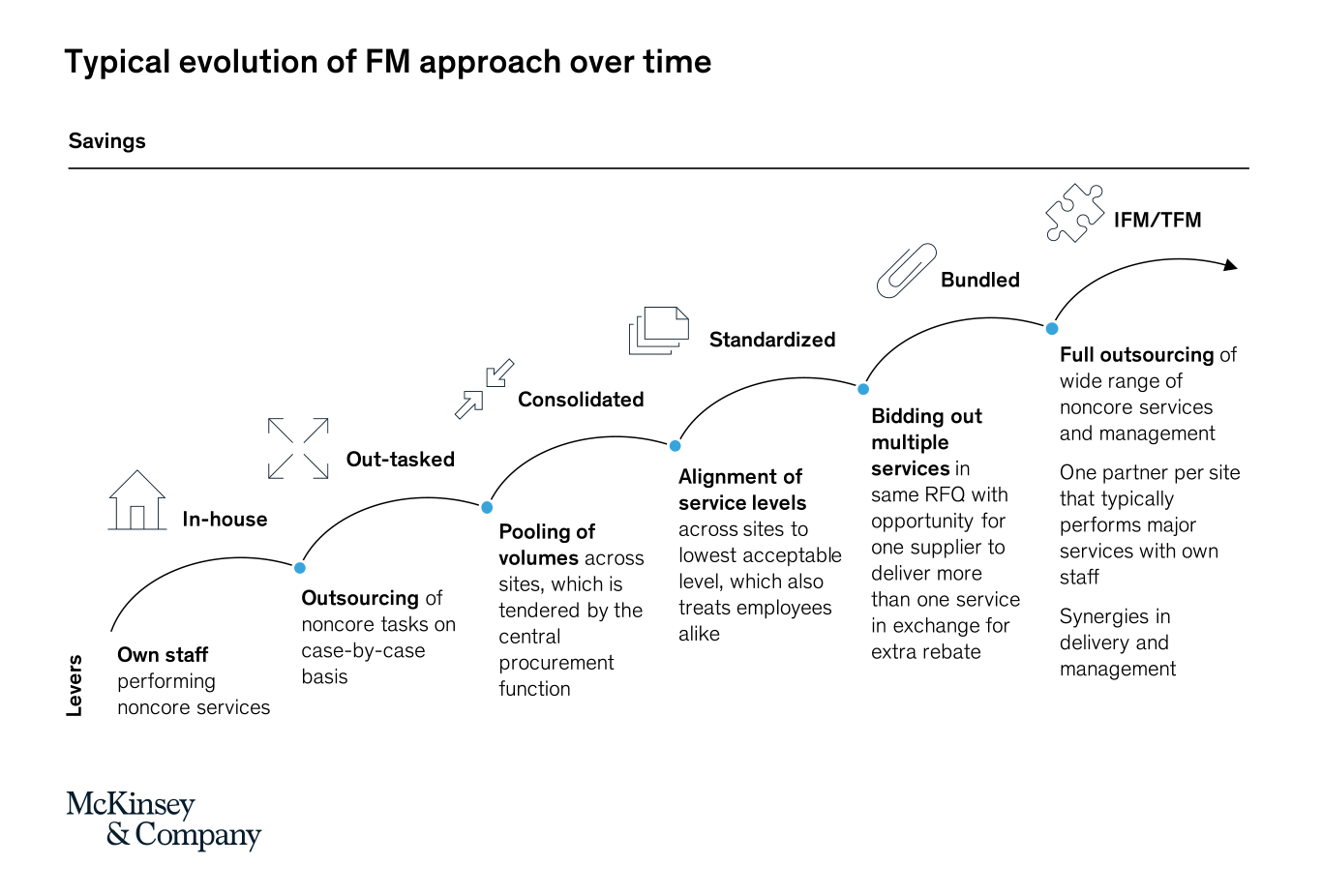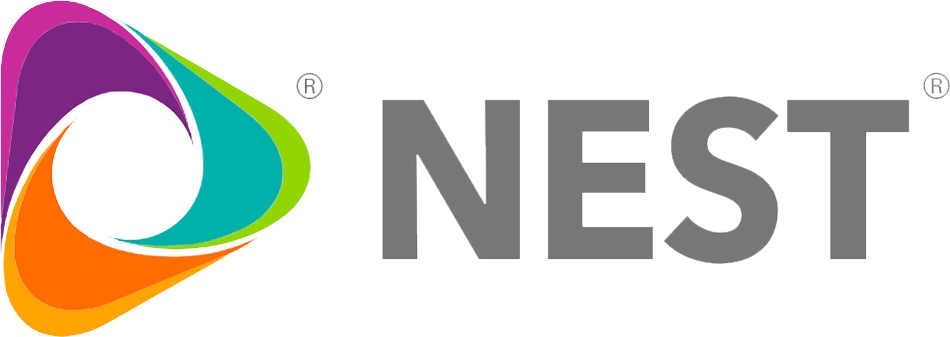After nearly two years of unprecedented economic disruption prompted by the coronavirus pandemic, two important themes have become increasingly apparent: Continuous agility across all business operations will be necessary for survival, let alone growth, and harnessing value from data will drive an organization’s ability to be nimble and resilient.
For large, multi-site organizations these ideas form the nexus of modern-day facilities management (FM). FM has grown into a top 10 operational expense and is only just starting to get the attention it deserves. Regardless of industry, FM is generally handled in-house these days and involves managing a shifting kaleidoscope of places, assets, technology, and human experiences that far eclipse its original scope.
It’s no surprise, then, that the outsourced FM industry has evolved with the growing complexity of organizational needs. It’s estimated that by 2024, the FM global outsourcing market will be worth $1 trillion, according to global management consulting firm McKinsey & Company.

(Source: "Typical Evolution of FM Approach Over Time," from "Six Emerging Trends in Facilities Management Sourcing" by McKinsey & Company, 2019)
While outsourced models can include various combinations of software, service provider networks, and operational support, industry trends suggest that the more effective and cost-efficient solutions, such as integrated facilities management (IFM) include all three, and more. In fact, some outsourced providers, in an attempt to keep up with the times, have made moves to beef up their offerings.
For example, one outsourced FM software provider recently transitioned from providing its clients with a directory of service providers as a referring partner to adding its own branded service delivery to augment its product suite. Unfortunately for the service providers, this means that the provider is now competing directly against them.
Indeed, today’s leading multi-facility organizations are increasingly turning to comprehensive outsourced IFM solutions to help move forward. With the capacity to impact employee productivity, the customer experience, and enterprise profitability, FM has become central to the strength of an organization's strategic footing.
Consequently, tomorrow’s IFM solutions will need to include the following features designed to deliver on that promise.
Comprehensive Technologies to Support Complex FM Programs
As aforementioned, today’s multi-site FM encompasses a wide range of functions designed to optimize productivity across facilities, assets, time, and people.
On the one hand, IFM providers must be able to support commercial workspaces that are increasingly connected, energy sensitive, and flexible; building management systems (BMS) that are complex and interconnected; and the likes of smart sensors, machine learning-powered maintenance protocols, and yes, even drones.
Simultaneously, and more often than not, they must also support legacy facilities with aging assets, inefficient systems, and outdated presentation一which may or may not easily retrofit to new tools and methods. Most large companies that seek IFM providers include some of both.
Technology offerings must, therefore, be customizable, adaptive, and include a fully integrative computer maintenance management system (CMMS) that includes the following features:
- Automated end-to-end work order distribution and service request management.
- An easy-to-use dashboard with customizable KPIs.
- An asset management database that includes history, notes, photos, programs, and warranty information.
- Mobile access integration to view assignments, status checks, and alerts from anywhere.
- Service verification functionality at the field level, including use of a customer satisfaction metric such as a net promoter score (NPS).
Data Protection & Cybersecurity
Threats to data and computer systems can keep facilities managers awake at night. The interconnectedness of BMS components, such as video surveillance, VoIP telephones, and office machines, often serves as an unsecured back door to business computer networks. If that weren’t enough to worry about, there are potential threats from the external vendors that service them, too.
In fact, according to leading business management journal Harvard Business Review, 60% of all cybersecurity breaches reported in 2017 by publicly traded companies were launched through the computer systems of suppliers or contractors, up from less than 25% in 2010.
Other cyber risks are more tangible, such as an attack on sensors that manage heating, air ducts, water, or wastewater, or even a breach of server room doors.
In tandem with an increased focus on security, then, comes a new kind of maintenance. IFM solutions will need to have protocols in place to support efforts to keep data and systems secure, such as SOC 2 (SOC 2) compliance and certification. SOC 2 is a leading auditing process developed by the American Institute of CPAs (AICPA) that ensures service providers work to secure client, employee, and company data.
Service Delivery Through Centralized Provider Networks
As service needs get more complex, so too does optimizing services across sites. Without an IFM solution in place, facilities managers who outsource are left managing a gaggle of vendors, performance standards, pricing disparities, and logistical challenges throughout the fleet. Furthermore, this typically low-cost approach often translates to subpar service quality.
IFM with a robust ISP network can make a significant difference to this part of the job and capture real savings. Tomorrow’s IFM solution should include a centralized ISP network with the following features:
- Scaled, negotiated fees.
- Weighted scorecarding.
- Comprehensive service level agreements (SLAs).
- A provider vetting protocol covering compliance status, insurance coverage, background checks, and performance.
- Filtering capability by specialty, performance, completion rate, service areas, and more.
Lower program costs achieved through ISP economies of scale一along with improved service outcomes一should be part of the overall solution.
Ability to Adapt Quickly
Like the clients they serve, IFM providers must adapt to changing conditions on a dime. For example, after this spring’s significant reduction in coronavirus cases, many companies worked overtime to reopen dormant sites and discontinue more rigorous cleaning protocols一only to have to return to higher levels of cleaning weeks later, thanks to the explosive spread of the Delta variant.
IFM providers must take a consultative approach in supporting their clients through ongoing uncertainty一which due to supply chain constraints, coronavirus variants, and other disruptions, could be with us for a while. They must be able to adjust the IFM program on the ground to facilitate service level changes of this magnitude and frequency and to minimize client site downtime, delays, and lost revenue opportunities.
Deep Program Visibility and Mobility
To optimize FM spend, tomorrow’s IFM solution must be able to provide deep visibility into a user’s FM program. This requires that users be able to access the work order software platform to capture granular data on work order and service request history, repairs and maintenance completed, parts required and sourced, invoicing, and so on. Important KPIs of program success, such as service verification, for example, must be fully measurable.
Providing mobile access to the platform is also a must-have to reduce equipment downtime and spend. Users should be able to initiate the work order process from the field and to review status checks and alerts from anywhere.
FM program technology must integrate with the user’s existing information systems—across finance, sales, marketing, operations, logistics, and other areas—to ensure that actionable data, such as service verification, program costs, and FM spend, is accessible when needed.
A Total Cost Approach
FM is still largely managed as a series of siloed tasks and functions spread across multiple sites using legacy cost models. This means service providers charge by the hour, along with trip charges, overtime costs, and emergency callout charges if fixes are needed after hours. Providers are often hired independently, with disparate pricing and service levels for the same services.
Access fees paid by service providers to utilize work order software and passed through to users are also generally part of the equation. In addition, legacy cost models include subscription or “tech fees.” These are charged to all users to leverage the system and subsidize future tech upgrades.
This ad hoc approach is rife with operational inefficiency and misses associated hidden interdependencies and costs in the program, such as the marginal loss in foot traffic (and revenue) when a service provider can’t get to a retail store to do a same-day HVAC fix, for example. And the larger the fleet, the more complex the challenge.
Tomorrow’s IFM solution, then, must use a total cost approach that holistically addresses FM and its various moving parts. As mentioned, negotiated pricing (instead of hourly pricing) and SLAs for ISPs facilitate better coordination across sites and improvements in workflows, maintenance scheduling, and their various collateral costs. With the right KPIs, operational inefficiencies throughout the program can be identified and mitigated一with meaningful savings achieved.
Importantly, a total cost approach also makes future budgeting more accurate and significantly easier.
Financial Planning & Predictive Analytics
An IFM solution for the future must provide users the insights to not only optimize their FM programs on the ground but inform organization-level strategizing, as well. FM program KPIs impact several organizational functions, and FM professionals are collaborating more with senior management and increasingly participating in C-suite strategy sessions.
To provide an organization with the data it needs, when it needs it, then, requires providing robust reporting, financial planning, and analytical support. This will enable users to:
- Manage budgeting better with accurate FM expense data. Track capital expenditures, seasonal variations, preventative maintenance, and other historical data.
- Improve forecasting with a comprehensive summary of expenses. Identify trends and patterns, and benchmark performance against industry standards.
- Identify cost savings opportunities with year-on-year spend breakdowns by category and period.
In short, data should be updated in real time with analytics to help identify trends. Importantly, this enables users to make proactive adjustments in current budget periods, and also educated predictions about future FM program needs.
Finally, exploring many of these features can facilitate the discussion of how best to approach FM as an organization, and how to use an IFM solution to better prepare for longevity, growth, and of course, change.
Contact NEST today to learn more about our IFM solution and how we can advance your FM program to the next level to help transform your business for the future.
This article was originally published as part of Going Far: Success in 2022 Through Integrated Facilities Management Partnership. To view the full report, you can download your free copy here.







